Investigating Past Climates
In order to predict our future climate, it's helpful to understand how and why the climate has changed in the past. Scientists use different types of clues to study the myriad ways that Earth's climate has changed during the past 4.5 billion years, including direct measurements, historical accounts, and paleoclimate proxy data, which are evidence of past climate preserved in fossils, sediments, ice and other places.
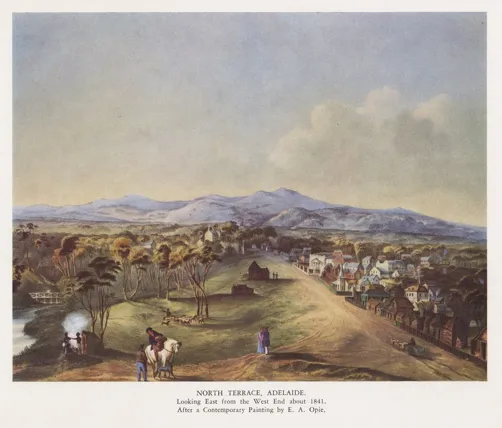
Sometimes paintings can provide a record of historical climate conditions when precise measurements are not possible.This painting by J. Hitchen depicts a heavy snowfall on the mountains along the horizon in southern Australia (1841).
State Library of South Australia, Historical Climatology
Today we can use technical instruments to make precise, quantitative, direct measurements of climate such as temperature, precipitation, and wind speeds. But to study the climate from beyond the last 150 years, historical records such as letters or journals, or any documentation of weather events such as droughts, floods, storms, especially frigid winters, or unusually hot summers can be used. Accounts of weather and climate span almost the entire period of recorded human history, which is roughly 5,000 years.
Although there are no direct ways to measure temperature or rainfall from before the time of recorded history, we can measure those things that were influenced by the climate. Various types of proxy data provide paleoclimatologists with indirect evidence about the climates of ancient times. Tree rings, ice cores from Greenland and Antarctica, sediments from the bottoms of lakes and seas, and many other natural proxy records of climatic conditions help us piece together the story of Earth's climates from the ancient past.
Paleoclimate proxies are clues to ancient climates.
Proxies are physical representations of the past that take the place of direct measurements. Some proxies represent a specific period of time, while others are more general. And some record only certain aspects of climatic conditions, such as temperature or precipitation.Proxies often have layers that formed during a certain amount of time, such as one year, or one growing season. For example, in tree rings, each layer represents a season of growth. Glaciers, the sediment at the bottom of lakes and the ocean, limestone that forms in caves, and the skeletons of coral all have layers too. Layers can vary in thickness, color, chemical composition, and other traits, which help to understand the climate at the time the layer was formed.
Sometimes separate proxy records have overlapping time frames that can be compared to provide a more complete record than they would individually. For example, consider tree-ring data from two different sources: the first is a tree that sprouted in the 1850s and was recently cut down, the second is one-hundred years worth of growth ring patterns in a wood beam from a log cabin that was built in the 1870s. Because there are overlapping times preserved in the two sources of tree-ring data, we can establish a proxy climate record that spans from the 1700s to the present day. This combining of records is done with layers in other types of proxies too, such as ice cores, corals, and sediment layers.
Types of paleoclimate proxies
Several types of proxies that are used to interpret past climates are described below.
Sediments from Lakes Beds and the Seafloor
The climate history preserved within layers of sediments that slowly accumulate on the bottoms of lakes and the ocean can span hundreds of millions of years. Sediment layers that are currently at the bottom of lakes or on the ocean floor are used to interpret climates of the recent past. Rocks preserved on the continents that are from thousands to billions of years old are used to interpret the much more distant past.
But where do the sediment layers come from? Sediments in lakes and on the ocean floor near the edge of continents are eroded from the land and carried to lakes and the ocean by rivers. As the moving water slows down, the suspended sediments settle to the bottom, gradually building up, layer upon layer. Winds can bring sediments such as volcanic ash and pollen to the water. These particles fall to the water surface and sink to the bottom. Skeletal remains of plankton and other aquatic life also settle to the bottom, particularly in deep-ocean environments. Often the uppermost layers of sediment are disturbed by storms, earthquakes, currents, underwater landslides, or burrowing organisms. This can make the proxy record less clear.
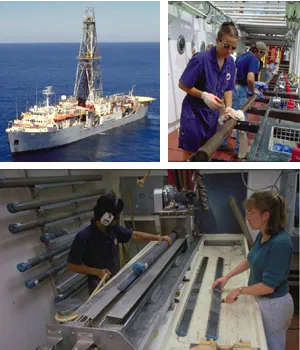
The ship JOIDES Resolution (top left) has recovered thousands of sediment cores from the ocean floor with a drilling rig. Scientists aboard the ship (top right) clean and prepare one of the cores soon after it was pulled up from the deep ocean. The long cores are cut into shorter segments and split lengthwise down the middle (lower).
Ocean Drilling Program
Under certain conditions, very clear and well-preserved records of climate are found in sediment layers. For example, in lakes without burrowing animals, the layers of sediment are undisturbed and alternating pairs of light and dark sediment layers, called varves, form. One pair of light and dark layers forms each year as the water flowing into the lake changes with the seasons - the layer of light-colored, mineral-rich sediment forms during colder months, and the layer of darker sediments that are rich in organic materials forms during warmer months.
Ice Cores
Some ice cores tell the story of climate from hundreds or even thousands of years ago. In areas where temperatures stay cold enough to prevent snow from melting during the summers, the ice contains an uninterrupted record of climate. Polar ice caps are good locations for the accumulation of layers of snow and ice. High-altitude glaciers, even in low-latitude regions, can also be a source of ice cores. As layer upon layer of new snow builds up, the older layers on the bottom gradually get compressed, transforming into a grainy material called firn, and eventually to solid ice. In Antarctic samples, solid ice is observed at a depth of about 100 meters. This ice layer can become quite deep over time - the 25 million year old East Antarctic Ice Sheet is more than 4.5 kilometers thick in places.
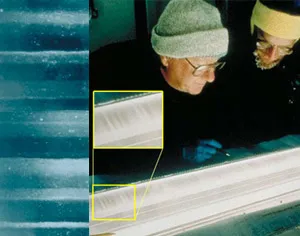
Scientists examine the layering in an ice core sample (right). Alternating light (summer) and dark (winter) layers together represent an annual record (left)
Ken Abbott/NOAA (Right) and Anthony Gow/NOAA (Left)
While the parts of an ice core that formed most recently have layers that show yearly variation, the older, deeper ice has been compressed so that layers of individual years cannot be distinguished. Typically, in ice samples from polar regions, the upper layers of ice have alternating light and dark layers. Light bands correspond to the relatively fresh, clean snows that fall in the summer when warmer conditions bring more moisture (and more precipitation) to these high-latitude glaciers. Dark bands mark the polar winter season, when little new snow falls on these frigid deserts and blowing snow is mixed with dust, discoloring the white snow. In many samples, the alternating light and dark layering is visible to the naked eye; in others, the layers can only be found by looking through polarized filters or through chemical analysis.
Most ice cores are collected from the vast ice sheets covering Greenland and Antarctica. The Greenland Ice Sheet is about three kilometers thick. This represents about 130,000 years of history, dating back to the last interglacial warm spell when Greenland was ice-free. The ice in Antarctica is slightly thicker (up to 4.5 km thick in some places) and contains a much longer record of climate. The oldest ice found in Antarctica was formed 2.7 million years ago. These differences in ice thickness are because the rate of snowfall varies from place to place.
Coral Reefs
Most coral animals live in colonies that build massive, stony, calcium carbonate (CaCO3 - limestone) skeletons over many years. The coral animals live on the surface of the skeleton and create layers of calcium carbonate over time. The layered structures that corals deposit as they grow have annual banding patterns similar to those found in tree rings, ice cores, and lake sediments. Lighter-shaded layers appear during the summer when growth is fast and darker layers form in the winter when growth slows. Coral colonies can live for centuries. Compiled coral data can span several hundred years.
The chemical composition of the layers provides scientists with clues about past climates, while the layered structure allows them to precisely date the changes they find. Analysis of ratios of different types of oxygen isotopes in corals tells us about sea temperatures, although variations in salinity can make these records more difficult to interpret.
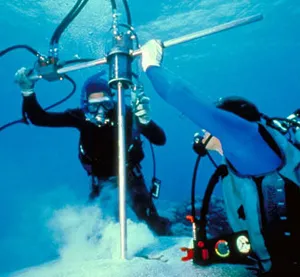
Scientists use a drill to extract a coral sample from Clipperton Atoll.
Maris Kazmers, Shark Song Photography
To gather coral reef proxy data from living corals, scientists dive into the ocean to drill core samples from the reefs. Although the annual banding patterns in the coral samples can sometimes be seen with the naked eye, in many cases X-ray imaging is required to clearly distinguish the bands. After scientists mark the annual layers in the X-ray images, they can extract samples from various layers for chemical and isotopic analysis.
Corals have a rather narrow range of environmental conditions that they can tolerate. They thrive only in warm (but not too warm!) tropical or subtropical oceans, in clear, shallow water. Most corals have a symbiotic relationship with a type of alga. The alga requires sunlight for photosynthesis, so corals that live with this alga are restricted to the ocean's photic zone (where sunlight shines through the water). Sensitivity to environmental factors makes coral a good gauge of local climate conditions. Modern and fossil corals are used to indicate other aspects of climate as well, such as changes in sea level, turbidity (cloudy or muddy water), and El Niño (ENSO) cycles.
Packrat Middens
Packrats, as their name implies, collect all kinds of materials from their surroundings. Their collections, called middens, provide clues to the past climates of the region. Packrat middens are composed of vegetation, insects, animal remains, and other materials cemented together by crystallized packrat urine (referred to as amberat). These rock-hard deposits can be more than 20,000 years old.
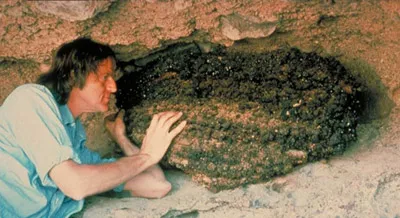
A scientist examines a packrat midden.
W. G. Spaulding/NOAA
Several species of packrats live in the arid deserts of western North America. Before scientists began examining middens, little was known about the past climates of desert regions of North America because other paleoclimate proxies such as tree rings, fossil pollen, ice and coral cores, and lake and ocean sediments are either absent from these regions or are too sparse to provide adequate data. The packrat middens turned out to be gold mines of data for climate researchers!
Materials encased in middens are often remarkably well-preserved. Scientists can sometimes even sequence DNA from vegetation in middens, which provides them with extraordinarily detailed insights into the evolution of plant communities, which in turn are good indicators of climatic conditions. Other astonishing artifacts have been discovered in middens. A midden from Utah contained a bone from a camel that, though once widespread in North America, had gone extinct more than 12,000 years ago.
Packrats are not the only animals that produce middens. These peculiar structures are also created by four families of rodents in South America (including a close relative of the Chinchilla), a stick-nest rat in Australia, a hyrax (a distant relative of elephants) in Africa and the Middle East, and a rock-dwelling vole in central Asia. Middens from these creatures are helping scientists reconstruct the former extent of vegetation in arid regions around the globe, and to discover the corresponding climate histories of those regions.
Speleothems
Limestone deposits in caves form stalactites, stalagmites, and flowstones. As a group, these features are called speleothems. Speleothems form when calcite (CaCO3) is released from water droplets that have percolated through rock into a cave. Speleothems form growth rings similar to those found in trees. The rate of growth of these features depends on how fast rainwater enters the cave, the mineral content and acidity of the water, and the temperature and humidity within the cave. The chemical composition of the growth rings (the oxygen isotopes, for example) is studied to better understand the chemical composition of the rainwater and hence the temperature and rainfall rate at the time of formation. Speleothems provide records that span from the present day back to about 25,000 years ago.
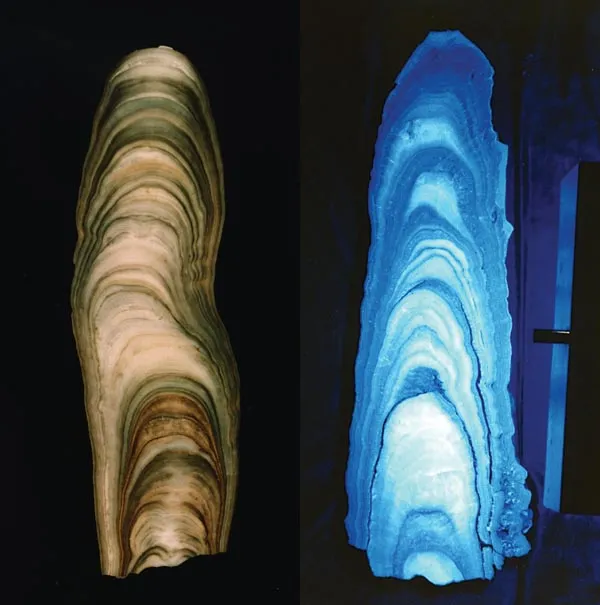
These stalagmites show growth rings characteristic of speleothems. The one on the right glows under ultraviolet light.
Paul Williams
Combining proxies for a deeper understanding of paleoclimate
By itself, one source of proxy data, such as a layer of sediment, can tell only a piece of the climate story. But when different types of paleoclimate proxies are considered together, such as fossils, tree rings, and sediment layers, they provide deeper insights into climates of the distant past.